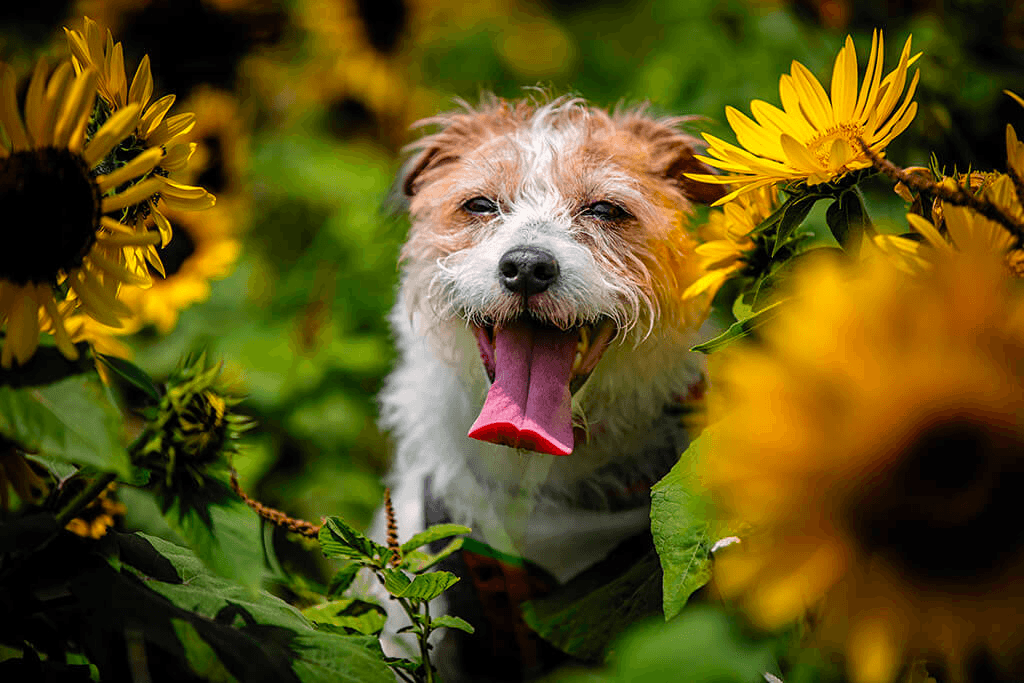A dog’s tongue may appear as different colors for a variety of reasons. We’ll break down what healthy dog tongues should look like and explain what shades may indicate a problem.
- Home/
- Dog/
- Health & Wellness/
- Dog Tongue Color Chart: Black, Blue, Purple & Spotted
Dog Tongue Color Chart: Black, Blue, Purple & Spotted

A dog’s tongue isn’t just good for giving puppy kisses and picking up dropped food morsels —
Your dog’s tongue can provide information about their overall health. Use our dog gum color chart to find out more about how the color of your dog’s tongue might clue you into how your dog is feeling.
Normal Dog Tongue Color: What Should It Be?
The normal dog tongue color for most of our canine companions is pink, with most dog tongues being a light pink or bubblegum pink color. Unlike cats, dogs do not have spines on their tongues, so the tongue should feel relatively smooth. A well-hydrated dog tongue should be moist to the touch.
Some dogs have black pigmented spots on their tongue, and a few dog breeds have naturally dark tongues that can look purple or blue.
An unhealthy dog tongue may have changes in color or texture. It’s important to familiarize yourself with what’s normal for your dog so that you can identify changes.
Dog Tongue Color Chart: What Different Shades Could Mean
If you’re noticing that the color of your dog’s tongue has changed color, it’s best to speak with your veterinarian.
This dog tongue color chart will explain the variations in tongue colors you might see and what they could mean.

Pink Dog Tongue
A dog tongue that is pink is usually a normal dog tongue. Note that most health conditions do not significantly affect the color of the tongue, so you shouldn’t rely solely on the color of your dog’s tongue to determine if they’re feeling alright.
Pale or White Dog Tongue
If you’re noticing that your dog’s tongue is pale or that your dog’s tongue is white, this usually indicates that your dog’s tongue isn’t getting enough blood flow. This can occur due to anemia (too few red blood cells) and other conditions. Potential causes include:
- Significant blood loss (hemorrhage)
- Bone marrow disease
- Autoimmune conditions that cause red blood cell destruction
- Parasites that feed on blood
- Parasites that affect red blood cells
- Being in shock
If you’re noticing a white or pale dog tongue, you should seek emergency veterinary attention, especially if:
- Your dog is acting lethargic and/or has collapsed
- Your dog has recently been injured or had surgery
- Your dog is actively bleeding or you’re noticing abnormal bruising
- Your dog is having trouble breathing

Red Dog Tongue
A dog’s tongue can appear red if they’re overheated. You’d typically notice this while they’re panting. It’s best to take your dog inside, into shade, get them water, and cool them off.
A bright red tongue color can also be a sign of carbon monoxide poisoning. If your dog has a red tongue and gums, is acting drowsy or uncoordinated, and/or is having difficulty breathing, seek emergency veterinary attention.
Wounds and infections on the tongue can also cause a red color. You should be more suspicious of a wound or infection if only a specific part of the tongue is red. Contact your veterinarian for an evaluation.
Yellow Dog Tongue
A yellow dog tongue is a sign of jaundice, which is usually caused by liver or gallbladder problems. This can also occur with ingestion of certain toxins that cause damage to the liver or red blood cells. Destruction of red blood cells sometimes results in jaundice.
A dog with jaundice usually needs emergent veterinary attention.
Blue or Purple Dog Tongue
If your dog normally has a pink tongue and their tongue is now blue or purple, this is a sign of low oxygen levels in your dog’s blood. A bluish tint to the mucous membranes, such as the tongue, is called cyanosis.
Cyanosis can occur due to breathing problems (e.g., pneumonia or collapsing trachea), heart disease, and some nervous system disorders that affect the breathing muscles. Seek emergency veterinary attention if you’re noticing your dog’s tongue has turned purple or blue.
In some dog breeds, such as Chow Chows, a blue or purple tongue is normal. Please note that in some cases, people call this tongue color black. A black dog tongue is usually a breed variation.
Spotted Dog Tongue
It’s common for some dog breeds to have blue or black spots on their tongue. In most cases, a spotted dog tongue isn’t a cause for concern.
However, if you’re noticing new dark spots, especially raised dark spots, contact your veterinarian. Some oral cancers, such as melanoma, can manifest as dark spots or bumps on the tongue.
Dog Breeds with Purple or Blue Tongues
If your dog normally has a pink tongue, a purple or blue tongue is abnormal. However, this tongue color is normal for some dog breeds.
Examples of breeds that can have normal purple or blue tongues include:
- Chow Chows
- Eurasiers
- Shar-Pei
- Thai Ridgebacks
Some dogs naturally have blue-black spots on their tongues, as well. Examples could include Akitas, Labrador Retrievers, Mastiffs, Newfoundlands, and more.
The reason these breeds have differently colored tongues comes down to their genetics. Specifically, genes related to pigment can affect what color the dog’s tongue is and the amount of melanin in their tongue.
Keep in mind that mixed breed dogs can also have blue or spotted tongues depending on what breeds are included in their genetic makeup.
How to Check Your Dog’s Tongue Color
Your dog may give you a peek at their tongue color all on their own when they’re panting. If they’re resting, you can try to check their tongue color by gently lifting their lips and looking at their tongue between their teeth. You can also use this opportunity to check their gum color, which should be similar to their tongue color.
Check your dog’s tongue color enough to get familiar with what is normal for them. If you’re concerned your dog may be acting abnormally, you can check the tongue color while looking them over. Make sure you’re checking in a well-lit room.
Remember that if you notice an abnormality in your dog’s tongue color, it’s best to seek veterinary attention. Using a dog tongue color chart can be useful, but it shouldn’t replace veterinary advice or insight.
Other Dog Tongue Problems
The tongue can also be affected by physical changes, such as inflammation, infection, tumors, warts, ulcers/sores, and wounds. Contact your veterinarian if you’re noticing any new bumps or lumps, red spots, or wounds.
Other signs that your dog could have an issue with their tongue include:
- Bad breath (halitosis)
- Excessive drooling
- Decreased appetite
- Difficulty eating
- Dropping food
- Visible bleeding
When to See Your Veterinarian
If you’re noticing a change to your dog’s tongue color, you’ll first want to rule out a simple cause. Did they eat something that stained their tongue? If no, evaluate how your dog is doing overall. If they’re otherwise acting normal, it’s generally okay to contact your veterinarian for an appointment.
A change to the tongue color usually indicates serious illness if the dog is also:
- Acting lethargic
- Vomiting
- Coughing or having difficulty breathing
- Fainting or collapsing
- Showing exercise intolerance
- Experiencing decreased appetite
- Actively bleeding
- Developing abnormal bruising
If you’re noticing that your dog’s tongue is pale, white, yellow, or abnormally blue or purple, it’s best to seek emergency veterinary attention.
Caring for Your Dog’s Tongue and Oral Health
One of the best ways to get familiar with your dog’s normal tongue appearance is to make dog dental health a priority. You can check over your dog’s gums and tongue when brushing teeth, which should be done at least three times per week.
Other steps you can take to keep your dog’s tongue and mouth healthy include:
- Ensuring access to water at all times
- Provide safe toys and treats for chewing (should have some flexibility or soft enough for you to indent the surface with a fingernail)
- Have regular veterinary check-ups that include an oral exam
- Say “yes” to preventative dental cleanings
- Get annual lab work to check on your dog’s overall health, including liver function
 R
R



